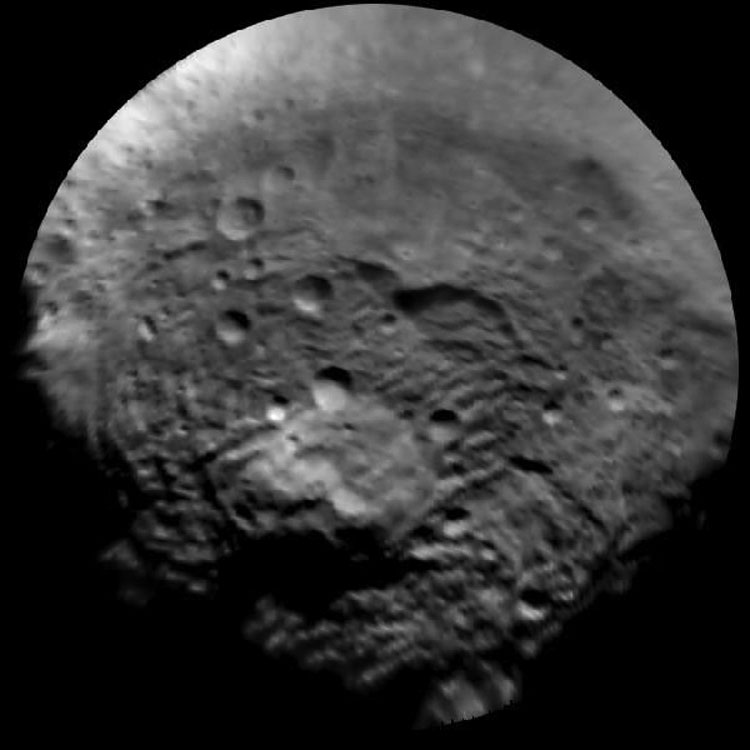Online Astronomy eText: Asteroids, Comets, and Interplanetary Debris
Ceres and Vesta
|
1/Ceres

(above) Four views of Ceres, obtained in 2004 with the Hubble Space Telescope. For a short time in the very early 1800's Ceres was thought to be a planet, despite its small size; but with the discovery of numerous other objects in the region between Mars and Jupiter, it gradually became clear that Ceres was merely the first (and largest, at 600 miles diameter) of a new class of small, or minor planets. Since they are so small that until recently, they could only be seen as dots, they eventually came to be called asteroids, meaning small objects that seem similar to stars, but are not. (Due to controversy over the 'major planet' status of Pluto, Ceres was designated a 'dwarf planet' in 2006).
If all goes well, Ceres and Vesta (the fourth asteroid discovered) will be orbited by the Dawn spacecraft (in 2015 and 2011, respectively). (NASA, ESA, J. Parker (SwRI) et al., apod060821) In preparation for the 2007 launch of the Dawn spacecraft, HST images of Ceres (left below) and Vesta (right below) were combined to produce high-contrast false-color images of those asteroids, which emphasize small differences in their reflective properties, to better show differences in their surface chemistry. (ESA, J. Parker (SRI), L. McFadden (U of Md), NASA)

4/Vesta

A topographic map of Vesta, created with the Hubble Space Telescope, in 1997 (B. Zellner (GSU), P. Thomas (Cornell), et al., WFPC2, HST, NASA, apod060820). As on topographic maps of the Earth, blue represents low areas, and red higher areas. The map shows a relatively rugged surface, highlighted by a single crater (bottom center) spanning the width of the asteroid. The central peak is a common feature in large craters.
Vesta is the fourth asteroid discovered, and the largest in the inner portion of the asteroid belt. Its nearest rival, Pallas, is about the same size, but significantly less massive. It appears that Vesta is primarily made of rocks similar to those in the interior of the Earth, while Pallas has large amounts of carbon compounds, as well as rocky material.
Vesta is thought to have had a tremendous collision about a billion years ago, which ejected large portions of its surface into space. Many smaller asteroids which have orbits similar to Vesta and many meteorites have optical properties similar to that of Vesta, suggesting that they are pieces of that asteroid. The HED meteorites are mostly pyroxene, which is a mineral commonly found in basaltic lava flows on Earth, and suggests the presence of volcanic activity on Vesta's surface prior to the impact which broke so many pieces off of it. No other asteroid is known to have had geological activity. Between that, and its relatively large size (a little over 300 miles diameter), Vesta has been considered as a planet candidate at various times; but the most recent IAU guidelines (still awaiting approval at this posting) would require objects to be considerably more spherical and at least half again as large as Vesta, to qualify for planet status.
The Dawn spacecraft went into orbit around Vesta on July 16, 2011. Over a period of a year the spacecraft studied Vesta at distances from a few thousand to (as the orbit was gradually tightened) a few hundred miles, photographing and studying it in unprecedented detail (eventually, it left Vesta and moved on to Ceres, for the end of its mission).

Above, a Dawn spacecraft image of Vesta taken on June 20, 2011, at a distance of 117,000 miles
(Image Credit NASA/JPL-Caltech/UCLA/MPS/DLR/IDA)
Below, an image of Vesta's south polar region, taken near Dawn orbital insertion on July 9, 2011
(Image Credit NASA/JPL-Caltech/UCLA/MPS/DLR/IDA)

Below, an image of Vesta taken shortly after entering orbit around Vesta, taken taken July 17, 2011
(Image Credit NASA/JPL-Caltech/UCLA/MPS/DLR/IDA)

Below, a size comparison of various asteroids visited by spacecraft by 2011; Vesta was by far the largest
(Image Credit NASA/JPL-Caltech/JAXA/ESA)

Below, a last look back at Vesta as the Dawn spacecraft left it en route to Ceres
(Image Credit NASA/JPL-Caltech/UCLA/MPS/DLR/IDA)

Below, a mosaic of the best images of Vesta taken by the DAWN spacecraft
(Image Credit NASA/JPL-Caltech/UCLA/MPS/DLR/IDA)

Below, Images of Vesta during one rotation(HST, WFPC2, B. Zellner (GA Southern Univ), NASA)
Click the image for an animation (ESA, L. McFadden (University of Maryland) and G. Bacon (STScI), NASA)

|
|